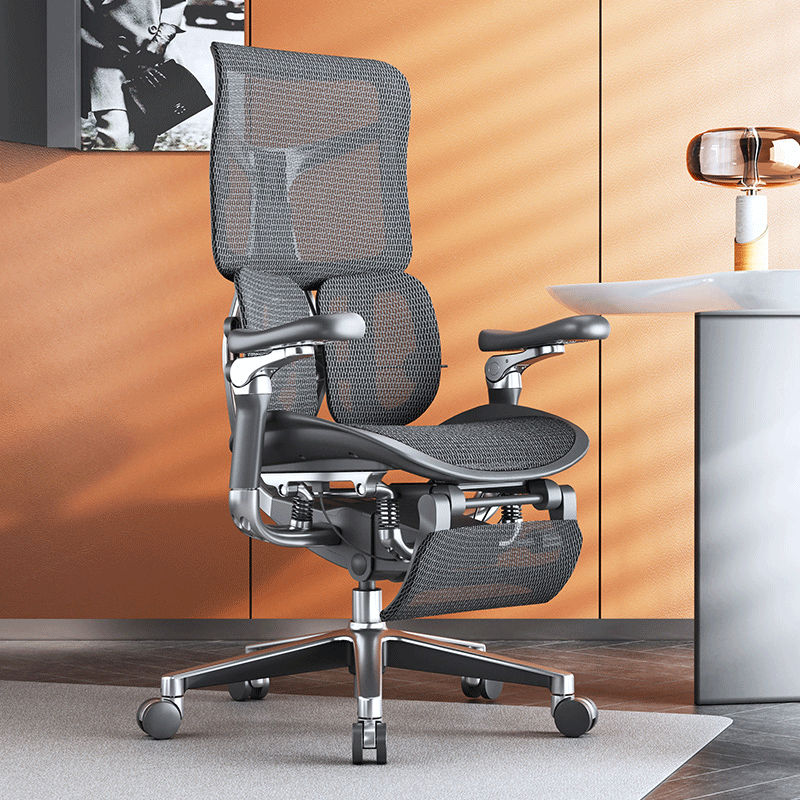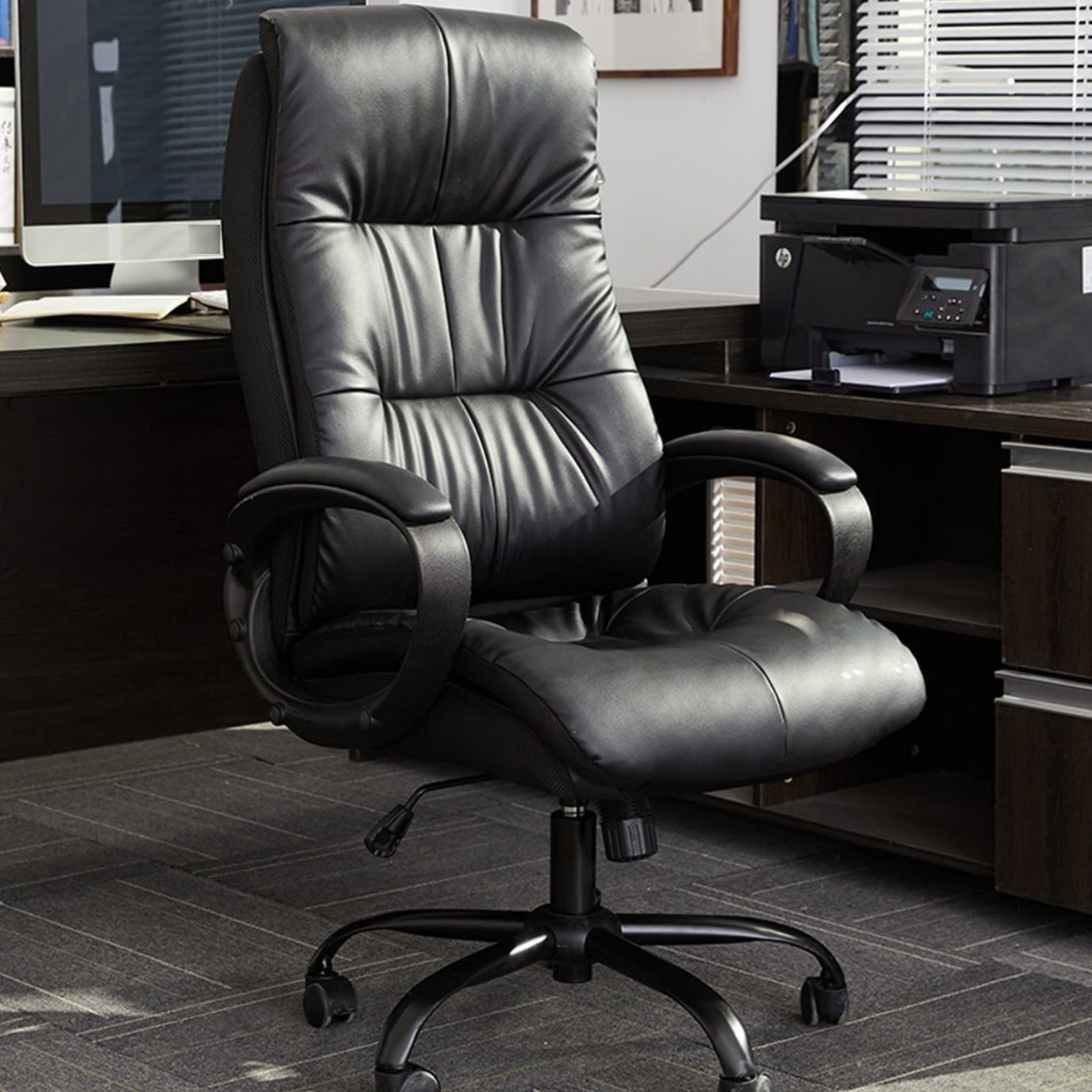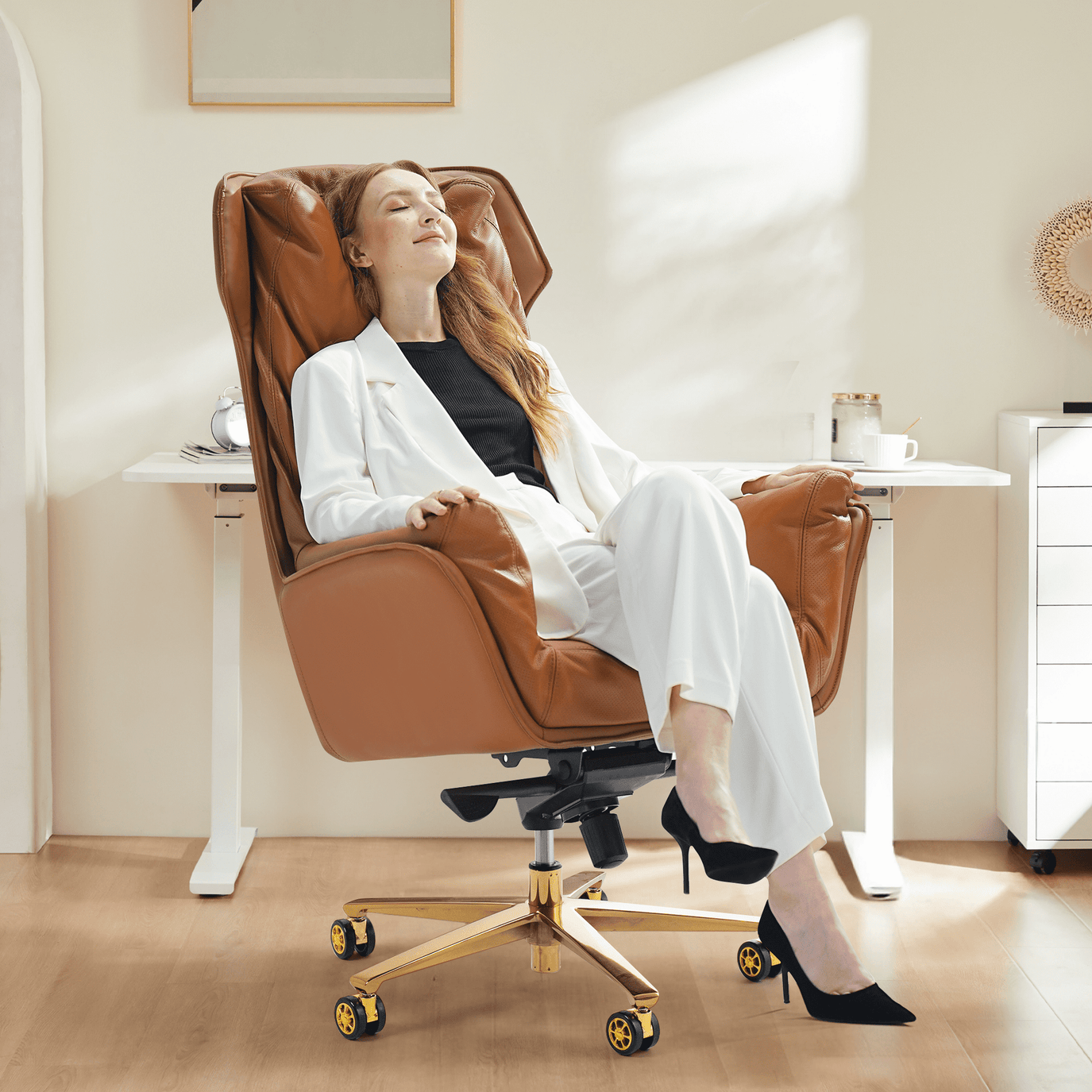In today's work world, people often sit for hours on end in office chairs, many of these chairs aren't built for comfort, which can lead to aches, pains, and even lasting health problems. This guide breaks down how to turn an uncomfortable office chair into a seat that boosts comfort and helps you get more done. We'll cover quick fixes, ways to make your chair fit your body better, and long-term answers to your seating woes.

Why is your office chair uncomfortable?
Before jumping into fixes, you need to figure out what's causing your discomfort. This part will help you look at your current office chair and workspace to spot the problems that need fixing.
Spotting Common Pain Points
A lot of people feel uncomfortable because of several usual issues with their office chairs. These include not enough lower back support, seat height that doesn't match your desk, armrests that sit too high or too low, and lack of padding. Each of these things can lead to bad posture and put more strain on your body, which causes pain and tiredness.
For example, if your lower back often hurts, your chair might not have good lumbar support. Also, if you feel pressure on your thighs or your feet can't rest flat on the floor, you may need to change your chair's height. Noticing these issues is the first step to make yourself more comfortable.

Evaluating Your Chair's Features
Chairs differ, and some have more ergonomic features than others. Begin by looking at what your chair offers right now:
- Lumbar Support: Does your chair have built-in lumbar support? If not, you might need to add an external lumbar pillow.
- Adjustability: Can you change the height, armrests, and backrest? A chair you can adjust lets you tailor your sitting position to suit your body better.
- Seat Cushioning: How firm or soft is the seat? A seat that's too hard can make you uncomfortable over time, while one that's too soft may not support you enough.
Understanding Ergonomics Basics
Ergonomics studies how to design workspaces that meet your body's needs cutting down on strain and boosting comfort. The main ideas behind ergonomics include keeping your spine in a neutral position, placing your feet flat on the floor, and making sure your arms have support at a comfy angle. Knowing these basics will help you to make the right tweaks to your chair and desk setup.
Take the neutral spine position as an example. This means maintaining your spine's natural curve, which you can do with good lower back support and the right seat height. Your feet should sit flat on the floor or a footrest, and your arms should form a right angle when you type or use a mouse.
And if you're in the market for a chair that makes these adjustments a breeze, check out the ergonomic options at Kinnls. We are chairs are designed with your comfort in mind, featuring easy-to-use adjustment mechanisms that help you create your ideal workspace setup.
Ways to Make an Office Chair More Comfortable
Height Adjustment
Let's begin with the base of comfort: the height of your chair. To get it spot-on, try to have your feet flat on the floor with your knees bent at 90-100 degrees. Most office chairs have a useful lever on the right. To lower the seat, just pull up the lever while you're sitting.
To raise it, stand up and pull the lever. To get the best comfort, set your chair 16-18 inches off the ground. This height helps spread your weight evenly and keeps your back straight all day at work. If your seat has padding, don't forget to subtract half its squished thickness from the perfect seat height.
Backrest Angle
The backrest angle comes next: it's key to back support. You'll find a lever on your chair's right side near the back. To adjust, pull the lever up to unlock the backrest. Move it to where you want then let go of the lever to lock it in place.
When you're doing computer work, it's best to set the backrest straight up. This helps you sit up and stay focused on your work. But if you're in a more laid-back situation, like chatting on the phone or brainstorming, you might want to lean back a bit. Just remember, if you lean back too far, you might need something to support your head so you don't strain your neck.

Seat Depth
This setting makes sure your thighs have good support and prevents pressure on the back of your knees. You can find the lever to adjust this on the left side of the chair. Try to get a seat depth between 15 and 18 inches. When you set it up, make sure you can fit 2-3 fingers between the front of the seat and the back of your knees. This gap helps your blood flow well and keeps you comfy when you sit for a long time.
Improving Back Support with Cushions
If your chair doesn't have built-in lower back support, you can make it more comfy by adding a lumbar pillow or cushion. These cushions support your spine's natural curve, which eases strain on your lower back. Try to find memory foam cushions that mold to your body's shape, giving you personalized support.
You might want to try a full-back cushion if your chair has a hard or uncomfortable backrest. These cushions provide support for your lower back and padding for your upper back, which helps you maintain good posture all day long.

Adding Seat Cushions for Comfort
Sitting on a thin or hard seat for a long time can make you uncomfortable. A seat cushion can give you the padding you need and spread your weight more evenly, which takes pressure off your hips and thighs. Many people like memory foam or gel cushions because they support you well and keep their shape for a long time.
When picking out a seat cushion, think about how thick and firm it is. If it's too thick, it might make your seat too high. On the other hand, if it's too soft, it might not give you enough support.
Add Ergonomic Support Accessories
After you tackle the main issues causing discomfort, it's time to boost your overall comfort with extra add-ons that can make a big difference in how you feel.
Footrests to Help You Sit Right
A footrest is a basic but useful add-on to help you sit better. By keeping your feet flat and your knees bent at a right angle, a footrest helps keep your spine in its natural shape. It also takes pressure off your lower back and helps your blood flow better. You can find footrests in many styles, including ones you can adjust to change the height and angle to fit what you need. Look for one with a surface that grips well to keep your feet from sliding around.
Adjusting Monitor Height
Your monitor's height has a big impact on neck strain reduction. The top of your screen should sit at or just below your eye level. This stops you from tilting your head down, which can cause discomfort and long-term problems like tech neck. A monitor stand or adjustable arm can help you set the right height. Laptop users can benefit from a stand that lifts the screen to eye level, along with a separate keyboard and mouse. This setup can make a huge difference.
Incorporating Ergonomic Wrist Supports
If you type a lot, wrist supports can help prevent strain and discomfort. These supports, made of gel or memory foam, keep your wrists in a neutral position. This cuts down the risk of getting injuries from repetitive motions, like carpal tunnel syndrome. Put the wrist supports in front of your keyboard and mouse. Make sure they're thick enough to keep your wrists level with the keys or mouse. This allows for a relaxed and comfy position.

Ways to Keep Your Daily Work Comfortable
Comfort doesn't just come from having the right gear; it also depends on how you use it. When you add these best practices to your daily routine, you can stay comfortable and healthy.
Taking Regular Breaks
Sitting for a long time can make you stiff and uncomfortable even with the best chair and setup. To fix this and keep your body flexible, you should stand up, stretch, and move around often. Try to take a quick break every 30 minutes. Get up, stretch your legs, and move your arms to get your blood moving. If you can, go for short walks even if it's just around your office.
Practicing Good Posture
Good posture helps you avoid pain and health problems down the road. Sit up straight, relax your shoulders, and keep your feet flat on the ground. Don't cross your legs, this can make you put your weight and strain your back. Use your chair's lower back support to prop up your spine and stop you from slouching. Line up your ears with your shoulders, and keep your chin level instead of pushing it forward.
Staying Hydrated and Active
Staying hydrated has an essential impact on your health and comfort. Not drinking enough water can make your muscles tired and sore, so remember to drink plenty of water throughout the day. Also, being active outside work can help offset the effects of sitting for long periods. Things like walking, yoga, or swimming can keep your muscles loose and lower the chances of getting pain from sitting all day.
Working out keeps your muscles strong and flexible, which you need for good posture and comfort while sitting. Even if you can't hit the gym every day, simple things like stretching, walking, or using a standing desk for part of your day can improve how you feel and your overall health.

Conclusion
Setting up a comfy and body-friendly office is key to keep you healthy and get more done if you sit at your desk for hours on end. Take a look at your current setup, make some quick tweaks, buy some ergonomic gear, and add in some top-notch products like those from Kinnls. These steps can turn an uncomfortable chair into a seat that helps you feel good.
Keep in mind, comfort isn't just about avoiding aches, it's about creating a workspace that lets you work well without putting extra stress on your body. If you follow the tips and advice in this guide, you can make your office chair a spot where you feel good and get lots done.
FAQs
Q1: How can I improve my chair's lumbar support?
A1: To enhance lumbar support, you need to maintain the natural curve of your spine and prevent lower back pain. If your chair doesn't have built-in lumbar support, you can add an external lumbar cushion. Memory foam lumbar pillows work well because they mold to your spine's shape, offering custom support. Also, if your chair has an adjustable backrest, position it to support your lower back's curve.
Tip: Kinnls offers ergonomic chairs with adjustable lumbar support letting you place the support where it benefits you most.
Q2: My chair doesn't have adjustable armrests. How can I reduce strain on my shoulders?
A2: Even without adjustable armrests, you can still minimize shoulder strain. One option is to use ergonomic armrest pads on top of your existing armrests. These pads offer cushioning and can increase the armrest height. Another solution is to use a desk with an adjustable keyboard tray, which allows you to position your arms at a comfortable level.
Q3: What should I do if my office chair is too hard and causes discomfort?
A3: If your chair's seat is too hard, a seat cushion can add padding and spread your weight more evenly. Memory foam or gel cushions work well because they keep their shape and stay comfortable for a long time. These cushions can also ease pressure on your hips and thighs, making it more comfortable to sit for long periods.
Tip: Make sure the cushion you pick doesn't make your seat too high, as this could throw off your posture and how you line up with your desk.
Q4: How do I know if my chair is at the correct height?
A4: You've got the right chair height when your feet sit flat on the floor and your knees bend at a right angle. Your hips should be a bit higher than your knees, with your thighs running parallel to the ground. This setup helps ease pressure on your lower back and boosts blood flow.
Tip: Can't adjust your chair or your feet don't touch the floor? Try a footrest to get the right posture.
Q5: How can I set up my monitor to avoid neck pain?
A5: Placing your monitor so the top of the screen sits at or just below eye level helps cut down on neck strain. This setup keeps your neck in a neutral position, steering clear of the downward tilt that often causes neck pain. If you work on a laptop, consider getting a stand to lift the screen and plug in a separate keyboard and mouse.
Q6: How should I step away from my desk to avoid discomfort from sitting?
A6: Take a short break every 30 minutes to stand, stretch, and move around. This helps avoid stiffness and boosts circulation. Even quick breaks to stretch your legs or shift your posture can reduce the discomfort linked to sitting for long periods.
Tip: Set a timer or use an app to remind you to take breaks, so you don't lose track of time while you work.
Q7: Does an ergonomic chair make a difference in comfort and productivity?
A7: Yes, an ergonomic chair can have a big impact on your comfort and how much you get done. These chairs are built to keep your body in a neutral position, which eases the strain on your muscles and joints. This support helps prevent aches and tiredness, letting you concentrate better and work more effectively. Buying a top-notch ergonomic chair such as those from Kinnls, can be one of the smartest choices you make for your workspace.
Tip: When you're looking for an ergonomic chair, pay attention to features like adjustable lower back support, seat depth, and armrests. You can customize all of these to fit your specific needs.



